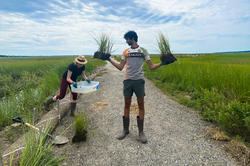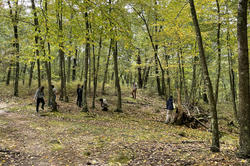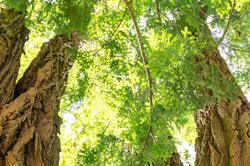Manini Banerjee, Varun Mehta, Avantika Velho and Katia Zolotovsky are developing mycelium-based biofiltration pods capable of reseeding lost wetlands.
RISD Students Create Engaging Objects for Roger Williams Park Zoo Animals

This fall, students enrolled in an Industrial Design studio called Design for Animal Enrichment worked with caretakers at the Roger Williams Park Zoo (RWPZoo) to develop puzzle feeders and stimulating toys that encourage giraffes, monkeys, snow leopards and other animals to exhibit behaviors typically displayed in the wild.
“Zoos aim to provide animals with habitats and experiences that are as close to their natural environments as possible,” says Amy Roberts, chief zoological officer at RWPZoo, “and enrichment plays a crucial role in achieving this goal, allowing their curiosity and intellect to be nurtured and stimulated.”
With guidance from faculty member Jennaca Davies MFA 07 JM, students spent hours observing the animals, speaking with zookeepers and researching behavior before creating long-term enrichment devices for selected species. “A primary goal of this course is to bring a non-human centered focus to design,” says Davies. “Students have to think of the animals as the users and take guidance from them, rather than relying on the human perspective. They must consider what happens when we allow the animals to provide the feedback.”
Students worked in groups to design more complex enrichment objects for two animals: the giraffe and the saki monkeys. The giraffe team developed a type of puzzle feeder that features a hanging barrel with PVC pipes inserted in the sides, designed to encourage the animals to use their long tongues to forage for food as they would in the wild. The team designing for the monkeys created a special see-saw that encourages collaborative play.


“A primary goal of this course is to bring a non-human centered focus to design. Students have to think of the animals as the users and take guidance from them.”
Skyler Lam 25 ID and Tess (Natnisha) Kitiyakara 25 ID collaborated on a project for the two resident snow leopards. “One big challenge is that the snow leopards are food aggressive,” Kitiyakara explains, “so we weren’t able to incorporate food in our design. We talked with the zookeepers about scents they might be attracted to, like certain herbs, spices and animal sheddings.”
After hours of observing the leopards and conversing with the keepers, Lam and Kitiyakara developed a model made of wooden 2x4s that they cut, sanded and configured into a barrel-like shape. The barrels are suspended above the ground so that they can spin and has several handles on the outside for the leopards to grab onto. “We wanted to encourage acrobatic behaviors, like climbing and jumping,” says Lam.
Other animals benefiting from the student designs include the bat-eared fox, wrinkled hornbill, tamandua (a small anteater), serval and golden lion tamarins. Lorna (Shuyang) Zhang 25 ID chose to design enrichment materials for the North American river otters, a curious species with extremely strong teeth. “The otters are very playful and easily distracted,” says Zhang, “and they have very sharp teeth and claws. If the toy is not strong or engaging enough, they can destroy it within a couple of days.”
Zhang chose to create two highly engaging, nontoxic toys for the otters, one for them to play with in the water and one to be used on land. The water toy features a square-shaped tube made out of clear PVC piping with colorful balls inside. The land toy is a type of feeding puzzle made of bamboo that the zoo staff provided.


At a final critique, students, zookeepers, faculty and local press gathered around the animals’ enclosures to watch each one interact with their new toys. While the bat-eared fox was wary of approaching his bug-feeding puzzle in front of the crowd, the tamandua dove right into his toy without hesitation, coming up for air occasionally with his snout covered in yogurt. The giraffes required some coaxing before enjoying their new feeder, and the North American river otters showed curiosity and cautiousness, running back and forth between land and water to evaluate the new additions.
“Hazard avoidance is an important part of surviving in the wild,” noted one of their keepers. “It’s okay that they are hesitant as they approach their new toys. That is self-preservation behavior that we like to see the animals display.”
After leading this second iteration of the course from start to finish, Davies reflected on the long-term implications of the students' work. “There is a sort of magic to being able to use design for conservation and animal welfare,” she says. “I know I'm doing my job well when I see the students begin to understand the larger, incredibly complex picture and by bringing these explorations to life, they see the potential their work can bring to preserving biodiversity and nurturing a more sustainable planet.”
Isabel Roberts / photos by Jo Sittenfeld MFA 08 PH
December 19, 2023


